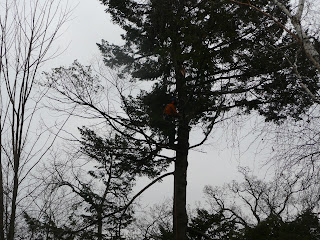Pruning large conifers presents certain problems for arborists. One big problem that we encounter is access. In the past many people who were tasked with removing material from large conifers would use spikes for "safety". This is a false premise. Using the Single Rope Technique is a much safer way to access large conifers because when done correctly, the climber always has immediate access to the ground. Additionally, the use of spikes is damaging to the tree.
In the following series I am pruning a large Douglas Fir over a house. It has some dead stubs and some hanging branches. I again use the SRT setup to safely and efficiently access the tree and perform the operation.
In the following series I have already pruned the large Douglas Fir to the left of the antenna. I provided clearance for the antenna and removed deadwood and hangers. I then descended into the top of the subordinate Douglas Fir. I cleared space for the little Douglas Fir within the Silver Maple that was growing around it. By doing this I reduce the conflict for space that was occurring between the subordinate Pseudotsuga and the Silver Maple. By doing so, I increase the trees' abilities to contribute more substantially to the landscape in the future.
The following series shows me pruning a small White Pine (Pinus strobus) for structure. Notice that it's necessary to access the very top of the tree to select an apical leader by eliminating a codominant branch. The top cut was at only about an inch and half diameter, but it was necessary to assure one main stem. The little pine was stout enough to support me in its canopy and the time was right for training pruning.
The following series shows me performing training pruning on small Sugar Maples (Acer saccharum). The small trees were at a great stage for training pruning. They had started to develop some problems such as multiple codominant leaders. This is not desireable because it leads to structural problems in the future. The whole point in training pruning is to invest in the tree's future by reducing the likelihood of developing structural issues as the tree grows. This is accomplished by making certain pruning cuts at appropriate locations to give the chosen stem the most sunlight at its apex.
The following series shows me pruning an American Elm (Ulmus americana) that got beat up pretty badly in a storm. It may have been tempting to simply cut it down. However, because it had become established and could contribute significantly to the landscape in the case that it could be fixed, I attempted to do so.
The following series shows me pruning a mature White Oak (Quercus alba). I set an access line high in the center of the tree. I use SRT to move about in the canopy and remove deadwood and prune large branches for structure over the driveway.
Pruning your trees is not only a good thing to do for your trees, it also allows you an opportunity to utilize the material produced from pruning to make compost and grow food. The plants that contribute to our landscapes could provide so much more for us if they were utilized to their fullest. Look at all of the material that was produced in the pruning outlined here! Contact Will at verticaltechniques@gmail.com or call 608-279-8394 to set up a consultation.
































Maximize your resource by setting up a consultation today! verticaltechniques@gmail.com
ReplyDeletethank you, for your information home designing i will try to Create a striking feature wall Pick an eye-popping wallpaper print and hang on the wall behind your bed to make a statement in your bedroom that oozes hotel style. Play with pattern proportions Wallpaper can make all the difference in a small bedroom
ReplyDelete